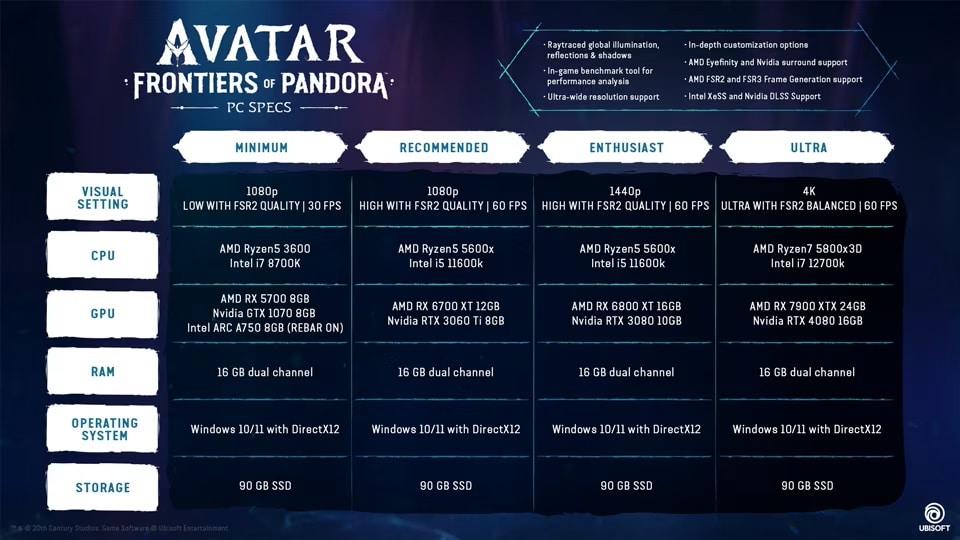
Ubisoft has revealed the PC system requirements for its upcoming game set in James Cameron’s Avatar universe that will be released on December 7. Avatar: Frontiers of Pandora will feature raytraced global illumination, reflections, and shadows, but as Ubisoft reveals its requirements one other thing does stand out, it will be among the small list of AMD-sponsored games in 2023 that supports upsampling technologies from all three GPU manufacturers at launch. There is a small catch though, according to the posted specs only FSR 2 and 3 will feature support for frame generation. Owners of ultra-wide, or multiple display configurations, can expect support for them on day one.
Per Ubisoft:
“In Avatar: Frontiers of Pandora, you play as a Na’vi learning to reconnect with your own homeland while reckoning with the human militaristic corporation known as the RDA. Ahead of launch, check out the recently unveiled PC specs, and catch up on some of the PC-specific features you can expect when Avatar: Frontiers of Pandora drops on December 7.”
The game appears to be very scalable across a wide range of PC technologies with CPU recommendations spanning from AMD Ryzen 5 3600/Intel i7 8700K up to an AMD Ryzen 7 5800X3D/Intel i7 12700K processor. Recommended GPUs must support DX12 and range from an AMD RX 5700 8 GB/NVIDIA GTX 1070 8 GB up to an AMD RX 7900XTX / NVIDIA RTX 4080. The ARC A750 is the only GPU from Intel listed on the recommended specs and is in the minimum category. SSDs are recommended for the game install which will use 90 GB of storage. Avatar: Frontiers of Pandora will also include its own benchmark utility so users can configure their systems for the optimal gameplay experience.
Ubisoft has said that the game will “deliver a smooth experience, stable FPS, and low latency in all resolutions”, and high frame rates with its support of high-core processors, optimal settings, and hardware.
PC specifications per resolution (per official page):
MINIMUM
Visual setting: 1080p, Low Preset with FSR2 Quality/30 FPS
CPU: AMD Ryzen5 3600 /Intel i7 8700K
GPU: AMD RX 5700 8GB /Nvidia GTX 1070 8GB /Intel ARC A750 8GB (REBAR ON)
RAM: 16 GB dual-channel
Storage: 90 GB SSD
Operating System: Windows 10/Windows 11 with DirectX12
RECOMMENDED
Visual setting: 1080p, High Preset with FSR2 Quality/60 FPS
CPU: AMD Ryzen5 5600x / Intel i5 11600k
GPU: AMD RX 6700 XT 12GB/ Nvidia RTX 3060 Ti 8GB
RAM: 16 GB dual-channel
Storage: 90 GB SSD
Operating System: Windows 10/Windows 11 with DirectX12
ENTHUSIAST
Visual setting: 1440p, High Preset with FSR2 Quality/60 FPS
CPU: AMD Ryzen5 5600x/ Intel i5 11600k
GPU: AMD RX 6800 XT 16GB/ Nvidia RTX 3080 10GB
RAM: 16 GB dual-channel
Storage Space: 90 GB SSD
Operating System: Windows 10/Windows 11 with DirectX12
ULTRA
Visual setting: 4K, Ultra Preset with FSR2 Balanced/60 FPS
CPU: AMD Ryzen7 5800x3D/ Intel i7 12700k
GPU: AMD RX 7900 XTX 24GB/ Nvidia RTX 4080 16GB
RAM: 16 GB dual-channel
Storage: 90 GB SSD
Operating System: Windows 10/Windows 11 with DirectX12

